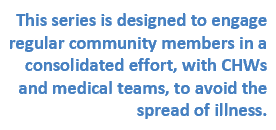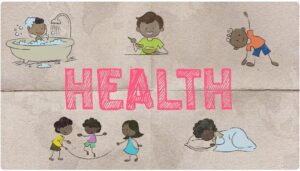WiRED International Completes Infectious Disease Prevention and Treatment Animation Package
Preparing Low-Resource Communities To Slow the Spread of Illness
By Allison Kozicharow; Edited by Elizabeth Fine
Background
How can already underserved regions of the world ward off illness now that global aid of medicines and vaccines has been severely reduced?
 In response to U.S. funding cuts for health care to under-resourced regions, WiRED International developed a strategy that includes the following elements: expanding our extensive inventory of health education modules, fortifying our community health worker (CHW)training program and producing disease prevention animations to bring entire communities into the fight against infectious diseases. Thirty new education modules are approaching completion and the augmented CHW training schedule is now in place. We are announcing today the release of the four and fifth animation in the five-part infectious disease series.
In response to U.S. funding cuts for health care to under-resourced regions, WiRED International developed a strategy that includes the following elements: expanding our extensive inventory of health education modules, fortifying our community health worker (CHW)training program and producing disease prevention animations to bring entire communities into the fight against infectious diseases. Thirty new education modules are approaching completion and the augmented CHW training schedule is now in place. We are announcing today the release of the four and fifth animation in the five-part infectious disease series.
This series is designed to engage regular community members in a consolidated effort, with CHWs and medical teams, to avoid the spread of illness. The animation series will be used in schools and by CHWs in their community health training sessions. We welcome anyone interested in teaching about infectious disease to use these videos in their training programs.
WiRED’s New Infectious Disease Prevention and Treatment Animation Series includes:
- Infectious Disease Basics
- Recognizing Signs and Symptoms of Illness (NEW!)
- Personal Hygiene and Healthy Living (NEW!)
- Water Sanitation and Purification
- Fighting Cholera Together
Summary of the Two Latest Animations in the Series
Personal Hygiene and Healthy Living Animation
This animation offers considerable educational value for students and their families. It teaches simple, powerful, daily habits to protect health and prevent disease, especially where resources are limited. Further, it provides evidence-based information on disease prevention and highlights the vital support role of CHWs. It teaches that small daily actions build a healthier, stronger future for individuals and the entire community.
 The core message is centered on daily preventative actions:
The core message is centered on daily preventative actions:
- Hygiene: Handwashing with soap and clean water is highlighted as the single most powerful tool against germs. Other key practices include using clean latrines, bathing and following food hygiene rules.
- Fueling the Body: It stresses the need for balanced nutrition (proteins, carbs and vitamins) with practical tips for limited-resource settings, such as mixing beans with rice for a complete protein and always drinking clean water.
- Movement and Rest: Viewers are encouraged to move for at least 60 minutes a day and aim for 7–9 hours of nightly sleep, essential for body repair and strength.
- Healthy Choices: The script covers avoiding drugs and alcohol, practicing safe sex and disease prevention through simple precautions like using mosquito nets and seeking early medical help.
- Community Support: The importance of mental health, supported by trusted friendships and communication, is discussed alongside the role of CHWs as local resources for education and basic care.
The module concludes by reinforcing the lesson that small, consistent daily actions collectively build a healthier, stronger future.
Recognizing Signs and Symptoms of Illness Animation
WiRED’s animation highlights the importance of recognizing signs and symptoms of illness early, especially in communities with limited access to doctors and nurses. The important information presented in this animation, designed for students and families, emphasizes that CHWs are essential in these settings.
 The animation presents several common, yet crucial, symptoms to watch closely, including:
The animation presents several common, yet crucial, symptoms to watch closely, including:
- A fever lasting more than two days or accompanied by chills,
- A worsening cough or fast breathing,
- Persistent tiredness or weakness that prevents work or school,
- Unusual changes in behavior or confusion and
- Stomach issues such as non-stop vomiting or diarrhea, especially with dehydration.
The animation describes how families should seek help immediately if symptoms are persistent, suddenly get worse or are severe or interfere with daily life. The message is clear: Don’t wait when warning signs appear.
WiRED’s CHWs are expertly trained to recognize danger signs, answer questions, provide simple treatments and, most critically, know when to connect families to a clinic or hospital. They serve as a “bridge to health and healing,” working with families to protect community health.
Conclusion
Disease has long been a top concern in low-resource countries due to fragile healthcare systems, poverty, conflict, famine and weather extremes from climate change. Throw global budget cuts into the mix and the situation in these communities becomes dire. Preventable deaths — highest in children — are already occurring and the projected rise in deaths to come is frightening (see the Impact Metrics Dashboard).
 Prevention won’t replace vaccines and medicines, but WiRED believes that community health begins with knowledge and continues with awareness. CHWs can teach their communities how to make healthy choices and share what they learn with others —and that can make a big difference in curbing the spread of disease. CHWs also form the bridge between people in their community and health professionals.
Prevention won’t replace vaccines and medicines, but WiRED believes that community health begins with knowledge and continues with awareness. CHWs can teach their communities how to make healthy choices and share what they learn with others —and that can make a big difference in curbing the spread of disease. CHWs also form the bridge between people in their community and health professionals.
The key takeaway from WiRED’s animations series is: Recognize. Respond. Reach Out.
Your support will help us continue delivering vital health education to communities most at risk–empowering them with the knowledge and tools to protect their health and their future.
WiRED’s Animators
Animator Frederica Sismondo
Federica Sismondo is a freelance 3D artist and motion graphics designer with over two decades of experience. Originally from Italy, she now resides in Copenhagen. Her expertise spans 3D modeling, animation, projection mapping and post-production, with her graphics work frequently featured in theaters, live events and television. Notably, Federica’s extensive credits include projection mapping on Disney castles in both Anaheim and Paris.
Several years ago, she created an impactful rheumatic heart disease animation for WiRED, which has since educated tens of thousands about the disease, its causes and prevention. Federica now dedicates her considerable skills to WiRED’s mission, helping millions in low-resource regions understand infectious diseases and how to prevent them.
Animator Jerilyn Lee
 Jerilyn Lee is an Asian American illustrator and designer based in the San Francisco Bay Area. They graduated from ArtCenter College of Design with a B.F.A. in illustration in 2023, and have been freelancing for various clients since then. They have a focus on editorial illustration and illustration for advertising, but branched out into many different areas of image making. Their artwork is heavily based on narratives that stem from experiences from life. Jerilyn uses primarily digital image making tools to create intricate drawings with vibrant colors. You can see more of their work at https://jerilynlee.com.
Jerilyn Lee is an Asian American illustrator and designer based in the San Francisco Bay Area. They graduated from ArtCenter College of Design with a B.F.A. in illustration in 2023, and have been freelancing for various clients since then. They have a focus on editorial illustration and illustration for advertising, but branched out into many different areas of image making. Their artwork is heavily based on narratives that stem from experiences from life. Jerilyn uses primarily digital image making tools to create intricate drawings with vibrant colors. You can see more of their work at https://jerilynlee.com.
Jerilyn Lee is the animator for the Cholera animation.


